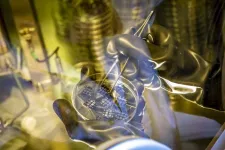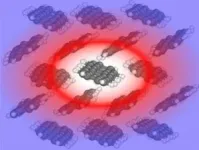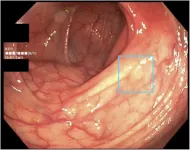(Press-News.org) Complex materials such as organic semiconductors or the microporous metal-organic frameworks known as MOFs are already being used for numerous applications such as OLED displays, solar cells, gas storage and water extraction. Nevertheless, they still harbour a few secrets. One of these has so far been a detailed understanding of how they transport thermal energy. Egbert Zojer’s research team at the Institute of Solid State Physics at Graz University of Technology (TU Graz), in collaboration with colleagues from TU Vienna and the University of Cambridge, has now cracked this secret using the example of organic semiconductors, opening up new perspectives for the development of innovative materials with customised thermal properties. The team has published its findings in the reputable journal npj Computational Materials.
Little attention given to heat transport up to now
“Scientists have been conducting research on charge transport in organic semiconductors for around 40 years, but no one has ever really looked at the detailed mechanisms relevant to heat transport,” explains Egbert Zojer. “However, the fundamental properties of materials are very interesting for us and the insights we have gained into heat transport in organic semiconductors are also directly relevant for many other complex materials. This applies both to materials in which low thermal conductivity is intended to achieve a large thermoelectric effect and to materials that are intended to efficiently supply or dissipate thermal energy through a high thermal conductivity. The fact that we can now determine and understand heat transport so precisely is unparalleled.”
The research team achieved this breakthrough by utilising machine learning in a context typically not in the focus when discussing applications of artificial intelligence. Instead of looking for correlations in empirical observations, the researchers searched for causalities based on the strategies they had developed in the past for the use of particularly efficient machine-learned potentials. They wanted to work out how and why heat is distributed in a certain way within a material. Previous explanations for heat transport assumed solely a particle-like transport of phonons also for complex crystalline materials like organic semiconductors. Phonons in this context are energy packets assigned to lattice vibrations, whose transport is typically described similarly to the transport of gas particles. However, the new findings show that an additional mechanism plays a decisive role: the tunnelling transport of phonons.
Molecular length is a decisive factor
Tunnelling transport is based on the wave-like character of atomic vibrations in solids and is particularly important in complex materials with low thermal conductivity. It has been shown that this transport mechanism becomes more important with the size of the molecules that form an organic semiconductor crystal.
“You can imagine that heat transport is not only determined by the collisions of the vibrational quanta, but also by a ‘tunnelling effect’ that couples two separate vibrational states with each other,” says Lukas Legenstein, author of the publication. “This finding not only explains why certain organic semiconductors exhibit an unusually low temperature dependence of their thermal conductivity, but also enables a more targeted design of materials with specific thermal properties. We can now influence heat conduction by specifically designing the molecular structure.” As a consequence, the researchers would like to apply this new knowledge to the versatile MOFs, as heat transport plays a crucial role in practically all potential applications for this class of materials – even more so than for organic semiconductors.
END
Graz University of Technology team decodes heat conduction of complex materials
Using machine learning workflows developed in-house, the researchers were able to establish that heat conduction is much more intricate than previously thought. Findings offer potential for developing specific materials.
2025-03-20
ELSE PRESS RELEASES FROM THIS DATE:
Cell atlas of the endometrium in women with PCOS may lead to better treatment
2025-03-20
Women with polycystic ovary syndrome (PCOS) find it harder to get pregnant, have more frequent miscarriages and have a higher risk of developing endometrial cancer. Now, in a new study published in Nature Medicine, Swedish researchers have shown that the uterine lining of these women differs in terms of both the composition of individual cells and gene expression. The results open the door to new drug treatments.
PCOS is the most common hormonal disorder affecting 11-13% of women of reproductive age. Women with the syndrome have difficulty getting pregnant and are at increased ...
New rules for the game of memory
2025-03-20
As animals experience new things, the connections between neurons, called synapses, strengthen or weaken in response to events and the activity they cause in the brain. Neuroscientists believe that synaptic plasticity, as these changes are called, plays an important role in storing memories.
However, the rules governing when and how much synapses change are not well understood. The traditional view is that the more two neurons fire together, the stronger their connection becomes; when they fire separately, their connection weakens.
New research ...
A simple way to control superconductivity
2025-03-20
Scientists from the RIKEN Center for Emergent Matter Science (CEMS) and collaborators have discovered a groundbreaking way to control superconductivity—an essential phenomenon for developing more energy-efficient technologies and quantum computing—by simply twisting atomically thin layers within a layered device. By adjusting the twist angle, they were able to finely tune the “superconducting gap,” which plays a key role in the behavior of these materials. The research was published in Nature Physics.
The superconducting gap is the energy threshold required to break apart Cooper pairs—bound electron pairs that enable superconductivity at low temperatures. ...
New CRISPR tool enables more seamless gene editing — and improved disease modeling
2025-03-20
New Haven, Conn. — Advances in the gene-editing technology known as CRISPR-Cas9 over the past 15 years have yielded important new insights into the roles that specific genes play in many diseases. But to date this technology — which allows scientists to use a “guide” RNA to modify DNA sequences and evaluate the effects — is able to target, delete, replace, or modify only single gene sequences with a single guide RNA and has limited ability to assess multiple genetic changes simultaneously.
Now, however, Yale scientists have developed a series of sophisticated mouse models using CRISPR (“clustered regularly ...
AI technology for colon cancer detection shows promise for widespread use – in the future
2025-03-20
The American Gastroenterological Association (AGA) released a new clinical guideline making no recommendation — for or against — the use of computer-aided detection systems (CADe) in colonoscopy. A rigorous review of evidence showed that artificial intelligence-assisted technology helps identify colorectal polyps. However, its impact on preventing colorectal cancer — the third most common cancer worldwide — remains unclear.
Colonoscopy, performed more than 15 million times annually in the U.S., is an effective tool for detecting and preventing colorectal cancer. CADe systems have been shown to improve polyp detection ...
Researchers identify promising drug candidates for previously “undruggable” cancer target
2025-03-20
For the first time scientists have identified promising drug candidates that bind irreversibly with a notoriously “undruggable” cancer protein target, permanently blocking it.
Transcription factors are proteins that act as ‘master switches’ of gene activity and play a key role in cancer development. Attempts over the years to design “small molecule” drugs that block them have been largely unsuccessful, so in recent years scientists have explored using peptides – small protein fragments – to block these “undruggable” targets.
Now researchers from the University of Bath have for ...
Smartwatch data: Study finds early health differences in long COVID patients
2025-03-20
[Vienna, 19.03.2025]—Between April 2020 and December 2022, over 535,000 people in Germany downloaded and activated the Corona Data Donation App (CDA). Of these, more than 120,000 voluntarily shared daily data from their smartwatches and fitness trackers with researchers, providing insights into vital functions such as resting heart rate and step count.
“These high-resolution data served as the starting point for our study,” explains CSH researcher Katharina Ledebur. “We were able to compare vital signs in 15-minute intervals before, during, and after a SARS-CoV-2 infection.”
Higher Resting Heart Rate ...
Mere whiff of penguin poo pushes krill to take frantic evasive action
2025-03-20
Imagine looking at the world through the stalked compound eyes of krill in the Southern Ocean. All of a sudden, a penguin appears like a voracious giant, streamlined like a torpedo, chasing and consuming thousands of krill at rapid speed.
Now, researchers have shown that the water-borne smell of the poo of these flightless birds is enough to cause the krill to show escape behaviors.
“Here we show for the first time that a small amount of penguin guano causes a sudden change in the feeding and swimming behaviors of Antarctic krill,” said Dr Nicole ...
Deep in the Mediterranean, in search of quantum gravity
2025-03-20
Quantum gravity is the missing link between general relativity and quantum mechanics, the yet-to-be-discovered key to a unified theory capable of explaining both the infinitely large and the infinitely small. The solution to this puzzle might lie in the humble neutrino, an elementary particle with no electric charge and almost invisible, as it rarely interacts with matter, passing through everything on our planet without consequences.
For this very reason, neutrinos are difficult to detect. However, in rare cases, ...
Parts of the brain that are needed to remember words identified
2025-03-20
The parts of the brain that are needed to remember words, and how these are affected by a common form of epilepsy, have been identified by a team of neurologists and neurosurgeons at UCL.
The new study, published in Brain Communications, found that shrinkage in the front and side of the brain (prefrontal, temporal and cingulate cortices, and the hippocampus) was linked to difficulty remembering words.
The new discovery highlights how the network that is involved in creating and storing word memories is dispersed throughout the brain.
This is particularly crucial for helping to understand conditions such as epilepsy, in which patients may have difficulty with remembering words. ...
LAST 30 PRESS RELEASES:
University of Oklahoma researcher awarded funding to pursue AI-powered material design
Exploring how the visual system recovers following injury
Support for parents with infants at pediatric check-ups leads to better reading and math skills in elementary school
Kids’ behavioral health is a growing share of family health costs
Day & night: Cancer disrupts the brain’s natural rhythm
COVID-19 vaccination significantly reduces risk to pregnant women and baby
The role of vaccination in maternal and perinatal outcomes associated with COVID-19 in pregnancy
Mayo Clinic smartwatch system helps parents shorten and defuse children's severe tantrums early
Behavioral health spending spikes to 40% of all children’s health expenditures, nearly doubling in a decade
Digital cognitive behavioral treatment for generalized anxiety disorder
Expenditures for pediatric behavioral health care over time and estimated family financial burden
Air conditioning in nursing homes and mortality during extreme heat
The Alps to lose a record number of glaciers in the next decade
What makes a good proton conductor?
New science reporting guide published for journalists in Bulgaria
New international study reveals major survival gaps among children with cancer
New science reporting guide published for journalists in Turkey
Scientists develop a smarter mRNA therapy that knows which cells to target
Neuroanatomy-informed brain–machine hybrid intelligence for robust acoustic target detection
Eight SwRI hydrogen projects funded by ENERGYWERX
The Lundquist Institute and its start-up company Vitalex Biosciences Announces Strategic Advancement of Second-Generation fungal Vaccine VXV-01 through Phase 1 Trials under $40 Million Competitive Con
Fine particles in pollution are associated with early signs of autoimmune disease
Review article | Towards a Global Ground-Based Earth Observatory (GGBEO): Leveraging existing systems and networks
Penn and UMich create world’s smallest programmable, autonomous robots
Cleveland researchers launch first major study to address ‘hidden performance killer’ in athletes
To connect across politics, try saying what you oppose
Modulating key interaction prevents virus from entering cells
Project explores barriers to NHS career progression facing international medical graduates
Jeonbuk National University researchers explore the impact of different seasonings on the flavor perception of Doenjang soup
Two Keck Medicine of USC Hospitals named Leapfrog Top Teaching Hospitals
[Press-News.org] Graz University of Technology team decodes heat conduction of complex materialsUsing machine learning workflows developed in-house, the researchers were able to establish that heat conduction is much more intricate than previously thought. Findings offer potential for developing specific materials.





